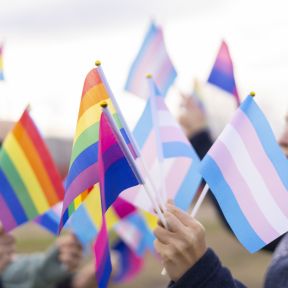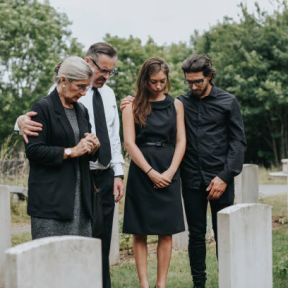Coping After Suicide Loss
Every year, hundreds of thousands of people die by suicide. Each one, research suggests, leaves behind an average of 6 to 10 “survivors”—spouses, parents, children, relatives, and close friends who are devastated and shocked by the death and who may not be sure how to navigate their grief.
Suicide loss can feel incredibly isolating. But no one who has lost someone to suicide is truly alone. Help is available in many forms—from friends and family, therapists, support groups, or one’s community. While the pain felt immediately after the death can seem insurmountable, it is possible to, with time, process it and start to feel hopeful again. Survivors may also, if they wish, take steps to honor their loved one’s memory and share his or her story with others; learning from the loss and using its lessons to bolster the mental wellbeing of others can be an important element of recovery.
For immediate help in the U.S., 24/7: Call 988 or go to 988lifeline.org. Outside of the U.S., visit the International Resources page for suicide hotlines in your country. To find a therapist near you, see the Psychology Today Therapy Directory.
On This Page
Losing someone to suicide triggers painful grief that, in many ways, differs from the grief triggered by other forms of loss. In addition to confusing and overwhelming emotions triggered by the death itself, anyone coping with the suicide of a loved one is often forced to also navigate stigma, shame, anger, and in some cases serious trauma. The grieving process is different for everyone, and there is no right or wrong way to mourn someone lost to suicide. It may take time—and go through many ups and downs—but most survivors find that they are eventually able to heal, make peace with the death, and come to find joy in life again.
Like any loved one’s death, suicide triggers deep feelings of grief and loss. Someone who has experienced a recent death, from any cause, may feel alone, abandoned, and unable to imagine life without the loved one. But suicide grief is complicated in ways that other kinds of grief may not be, and its complexities can serve to magnify someone’s pain or make them feel as if no one else could possibly understand what they’re going through.
For one, losing someone to suicide is often traumatic. Someone may discover or have to identify their loved one’s body; the method of suicide may be violent; they may even have to talk to the police afterward. Some who lost a loved one to suicide may be initially unsure if the death was a suicide or a homicide; learning later that the death was self-inflicted can feel agonizing or overwhelming. Trying to come to terms with the loss and the trauma can feel like a double blow.
Suicide also triggers an unfathomable rush of emotions: anger, sadness, shame, loneliness, guilt, and on and on. Survivors may convince themselves that they could’ve prevented the death; they may feel like a terrible person for being unaware that their loved one was in such pain. Such emotions are in themselves challenging to navigate—but since many cultures or religions condemn suicide or consider it taboo, survivors often feel obligated to keep them to themselves. This typically only serves to render the loss more painful and isolating.
After someone dies by suicide, the survivors who are left behind often find themselves overwhelmed by guilt. Thoughts like “Why didn’t I know he was in so much pain?” or “Could I have stopped her from doing this?” become repetitive and haunting.
But the reality is that many people who die by suicide make an effort to hide their intentions—and the depth of their despair—from the people around them. And even if they do display external signs of suicidal ideation, few laypeople are aware of what those signs look like or what they could indicate. Someone may reject offers of help outright—or seem to make progress before sinking back into despair.
Self-blame is a common response to a loved one’s suicide, but it’s important to remember that simply feeling the emotion does not make it truthful. Suicide is in many ways unpredictable, and someone’s decision to kill themselves is entirely their own. Seeking support from others—either a therapist, a family member, a friend, or a trusted community member—can help someone make sense of pervasive feelings of guilt and recognize that they are not to blame for their loved one’s death.
After a loved one’s suicide, it’s common to feel a veritable smorgasbord of emotions: many survivors report feeling devastated, furious, relieved, guilty, ashamed, confused, and more, all at once or in combinations that seem to make no sense. They may feel on-edge or even out of control; some survivors find themselves bursting into tears randomly or flying into sudden rages over small annoyances. Others may feel numb or empty; this, too, is a normal response to suicide bereavement.
Such conflicting emotions arise because suicide is tragic, baffling, and often seems to happen out-of-the-blue. It takes time to come to terms with what happened, and it’s common for intense emotions to ebb and flow as someone navigates their grief. Acknowledging the feelings, taking steps to process them (rather than trying to quash or ignore them), and practicing self-compassion are all important stages of grieving and recovery.
Yes. Many survivors of suicide loss feel immense anger toward their loved one—for abandoning them, for causing them such awful pain, or for not trusting them enough to share their despair. It’s even normal to feel like the death is a personal rejection; someone may secretly suspect that if they were different or somehow more “special,” their loved one would not have chosen to take their own life. While this feeling isn’t based in reality, feeling rejected is agonizing and can further exacerbate rage.
It’s also normal to feel angry at others—or even yourself—for missing clues of suicidal ideation or not doing enough to help. But while self-blame is a common after-effect of a suicide death, it’s important not to wallow in it. Talking to a therapist or trusted loved one can help someone realize that their anger, while understandable, is misguided.
Many who die by suicide spent many months or years prior struggling with serious mental health issues, substance abuse, or other ongoing challenges that, in addition to being difficult for the individual to navigate, may have put their loved ones under considerable stress. Countless nights spent worrying about someone—”Is she safe?” “Is he using drugs?” “Will I ever see her again?”—can wreak a serious mental and physical toll. Thus, their death may bring, along with immense pain, some small measure of relief—at least now, someone might feel, the uncertainty and anxiety are finally over.
Feeling even a glimmer of relief, however, often fuels significant guilt and shame in survivors. But relief is a common and psychologically understandable component of many people’s suicide grief. It’s OK to grapple with feelings of relief, and it’s OK to share these feelings with trusted others.
Suicide survivors are at heightened risk of developing symptoms of post-traumatic stress disorder after their loved one’s suicide. This may be especially likely if the suicide method was violent, if the survivor personally discovered the death, or if it was preceded by a history of suicide attempts that heightened the survivor’s anxiety. Anyone who has lost of loved one to suicide who is experiencing symptoms of PTSD—such as flashbacks, nightmares, anxiety, trouble sleeping, or dissociation—should seek help from a trained mental health professional as soon as possible.
Sadly, research has found that suicide survivors are at a heightened risk of taking their own lives. Immense grief can trigger the feelings of despair and hopelessness that can breed suicidal thoughts—and because suicide survivors tend to suffer in silence, they may be less likely to share their suicidal ideation with others or seek needed help. There is no shame in feeling suicidal after a loved one’s suicide, but it’s important to reach out for help as soon as possible. Anyone who is having suicidal thoughts should call a suicide hotline in their country or a local emergency number. Those in the U.S. can call 1-800-273-8255; those in other countries can search for local resources on the Suicide Hotlines and Prevention Resources page.
Anyone who has lost someone to suicide can benefit from support, in whatever form makes sense for them. For many, this is a therapist; for others, connecting with a support group or a faith community can be healing. Others are able to cope with help from their family, friends, spouses, and other loved ones. Whatever form it takes, it's imperative that survivors have a safe space where they can process painful emotions, express any conflicted feelings, and come to terms with their loved one's passing.
Family and friends can be of great help to a suicide survivor’s recovery—offering both emotional and practical support (cooking meals, taking care of the funeral proceedings, etc.) that allows the survivor space to cope with their grief. Beyond that, talking to an individual therapist can help someone navigate their more difficult and confusing emotions; if the survivor is themselves experiencing suicidal thoughts, individual therapy is imperative (in addition to more immediate help from suicide hotlines or local emergency resources, if necessary). Grief support groups—especially those geared specifically toward suicide survivors, if available—are also a valuable resource, and one that can continue to provide support for weeks or months after the death.
Visiting a support group—and hearing others’ stories of love, loss, and healing—can be an effective weapon against the pervasive feeling of isolation that is common for suicide survivors. Support group members often take great comfort in knowing that their compatriots truly understand what they’re going through; in the safe space of a support group, they may finally feel comfortable talking about the more confusing emotions, like anger or relief, that they’ve hesitated to share with others. On top of that, the routine of regular sessions can help survivors escape from the seemingly endless despair and loneliness that can follow a suicide loss. And by forging bonds with others and getting a glimpse at their recovery process, survivors can learn more effective coping skills and start to envision how their own grief will become manageable over time.
It’s normal for others to avoid or dance around the subject of suicide or seem awkward or nervous if it’s brought up. If a particularly uncomfortable person is a close loved one whose support would be invaluable, it can be helpful to share resources on how they can best be there for you during this period of deep mourning. If you’re able, it can be helpful to tell them directly that they don’t need to say the “perfect” thing, and that you know that they won’t be able to fix what happened. Let them know it’s okay to just sit with you and let you talk (or not). Even the most empathetic person may struggle to recognize how much their silence or discomfort is hurting you; thus, it can be helpful to let them know that others’ presence and understanding are often critical components of a survivor’s recovery.
Many survivors find strength in faith communities, if they’re religious or spiritual. Reading books about suicide loss or other kinds of grief—especially personal memoirs—can also be helpful, particularly for those who aren’t able to attend a support group or share their story with other survivors. Connecting with mental health organizations that speak out against suicide stigma, or even starting an organization in the loved one’s name, have helped many suicide survivors make sense of their loss and honor their loved one’s memory.
Someone who has lost a loved one to suicide is likely in desperate need of support from the people around them, even if they’re not always able to express it. Reach out to them regularly, and make it clear that you’re available to talk—or go for a walk, or just sit together in silence, if they prefer—whenever they need. Listen to their story without judgment, as many times as they need to tell it; it’s normal for a suicide survivor to repeat themselves or fixate on certain elements of the loss as they try to process it. Don't be afraid to say their loved one's name or ask directly how they're coping with the death; dancing around the subject will likely only heighten their feelings of isolation and grief.
If you have never lost someone to suicide, it's important to remember that it's emotionally devastating in ways that may seem overwhelming to others. Your loved one’s feelings will likely be intense; they may lash out at you, start crying unexpectedly, or seem to shut down at times. Thus, mentally preparing yourself for the strength of their emotions and accepting that their grief may come in waves will help you be as supportive as possible. Reading books or watching videos about suicide loss can be helpful in this regard.
Some survivors, especially in the immediate aftermath, will be so stricken with grief that they will struggle to manage day-to-day tasks; similarly, they may be too overwhelmed to deal with necessary arrangements. Offering practical support—whether that’s dropping off meals, taking on childcare, helping plan the funeral, or locating a support group in their area—can be enormously helpful as they work to keep their head above water.
Suicide, sadly, remains highly stigmatized in many societies, and many people who lose a loved one to suicide feel pressure—either spoken or unspoken—to keep the cause of the death a secret, or to keep their conflicted feelings about it to themselves. This stigma can be immensely harmful, both to the survivors themselves and to others in the community who may be struggling with suicidal thoughts but are hesitant to speak out for fear of retribution.
Pushing back against stigma in its entirety likely requires large-scale societal change, which is happening slowly but surely. But in the meantime, individuals can help reduce stigma by speaking openly and honestly about suicide and refusing to be ashamed that their loved one lost their battle with suicidal thoughts.
Cultural stigma related to suicide likely has several sources. Despite progress in recent decades, many cultures still view any mental health disorder as an aberration—feeling depressed, for example, is viewed by many as a personal or familial failing. Collectivist cultures may look down on mental illness or suicide as bringing shame to the family or community, while individualist cultures may perceive a mentally ill or suicidal person as weak or lacking in independence or self-sufficiency; both interpretations of mental illness serve to perpetuate stigma.
Suicide stigma can also stem from religious influences. Many major religions posit that suicide is a “sin”; in some, those who died by suicide are not able to receive religious burials as a result, and some religious groups may make an effort to shun the families of those who died in this manner. This can compel survivors to hide the manner of their loved one’s death, which further increases the silence and sense of shame that surrounds suicide.
Post-suicide shame is common, and is largely the result of societal stigma. Even if someone doesn’t personally believe cultural myths about the morality of suicide, they may find their influence pernicious and difficult to escape. It’s still common, for example, for those who die by suicide to be called “selfish” or “cowardly,” or have others publicly speculate that there “must have been something wrong with them”—leading their loved ones to feel unsupported or on the defensive.
Certain families or communities may go so far as to cut off contact with suicide survivors or behave as if the death didn’t occur. Because of the possibility of social consequences, some families decide to keep the cause of their loved one’s death a secret, which can lead to arguments or tension if some members would prefer to be honest about the death. Some survivors report that feeling avoided or silenced caused them deep pain and exacerbated their feelings of shame or worthlessness.
It’s also common for survivors to grapple with deep-seated fears that the suicide was their fault in some way; admitting to others the nature of the death, then, may feel like admitting one’s own guilt or personal failings.
Suicide survivors often find that the people around them avoid talking about the death, offer platitudes (“at least he’s in a better place”) in place of real support, or express impatience or surprise that the survivor isn’t “over it” yet. While it can be frustrating and isolating to feel like others are uncomfortable talking about the loss, it’s important to remember that this discomfort is not necessarily coming from a place of malice. Many people simply don’t know how to support someone who has lost a loved one to suicide. They may think nothing they say will be enough, so they opt to stay silent; they may hope that rote phrases like “everything happens for a reason” will provide comfort. For some, the very idea of suicide is so frightening or confusing that they find themselves changing the subject whenever it comes up as a way to escape their own anxiety.














